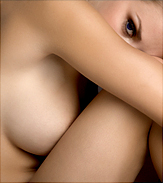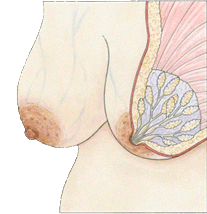
Fleshing It Out
Anatomy of the Breasts
While on our program you will find yourself more focused on your breasts than at any other time and envisioning your breasts fuller, firmer, larger, more voluptuous. This impresses the image of the breasts you desire upon your subconscious mind. A basic understanding of breast anatomy and mammogenesis can help you visulaize what is taking place as you grow.
The mammary gland is actually a collective term for all the tissues that contain the glands that can make milk. Your breasts are comprised of an epithelial parenchyma and a connective and adipose stroma. The parenchyma is a system of branching ducts and glandular structures that intermingle with a mixture of fibrous and loose connective and fatty tissues known as the "mammary stroma. "Most of the fat deposited outside the "milk machinery" is laid to form the subcutaneous pad just under the skin.
There are 15 to 20 major lobes, "each one possessing an independent canal through which milk is conducted toward the nipple (Soucasaux, 1993, para 1)." Each lobe consists of a great number of lobules. The lobules, in turn, are comprised of from 10 to 100 acini (or alveoli) grouped together around a space into which the milk is ejected.

Ancini are the hollow sacks that make and hold milk. They are only a few millimeters in size and are lined with milk-secreting cuboidal cells. A hormone called oxytocin, stimulated during breast feeding, signals myoepithelial cells surrounding the individual alveoli to contract and eject milk into the collecting duct.
Suspensory ligaments are part of the mammary stroma. They are responsible for "holding up" the entire breast structure in its position by keeping it "anchored" both on the skin and on the great pectoral muscle.
The quantity and dimensions of tissues comprising the parenchyma vary greatly from woman to woman. Great variations in these glandular structures are also found in the same woman according to her phase in life and its respective hormonal influences.
NaturalWoman® is designed to re-create hormonal conditions necessary to restore breasts back to their firm pre-involution state as well as provide another opportunity for growth beyond original cup size.
Giving rise to breasts, mammogenesis

"… the ultimate function of the human breast becomes clear only when an infant is born and lactation begins."
Carole Jahme, Image by Alexander Tsiaras
The breasts are the only part of the anatomy left unfinished at birth. The rudimentary structures, however, have existed in both sexes since embryotic life. From infancy to just before puberty, there is no difference between the female and male breasts. When girls reach adolescence, hormones are released and breasts grow in preparation to bear a child. It is at this time testosterone kicks in to prevent male breasts from developing any further.
Mammogenesis, simply defined as the growth and development of the mammary gland, is actually an extended stage in a woman's life that starts at the onset of puberty and continues throughout pregnancy, with the majority of functional breast development occurring during puberty and during pregnancy (Lauwers, J., 2005). In between these two periods of increased hormonal activity, each menstrual cycle "fosters further mammary development that never regresses to its former state of the preceding cycle… (Riordan 68)", but development is not considered complete until a woman has given birth and lactation begins.
Once the ovaries are secreting estrogen, the ductal (canalicular) system will proliferate. This occurs in an increasingly branching pattern, like the growth of the branches in a tree, "and, at the final extremities of their smaller branches, epithelial sprouts that will originate the mammary acini are formed (Soucasaux, 1993, para 8)." A thick layer of fat that forms outside the parenchyma and under the skin dictates their preliminary size and shape.
Estrogen alone is responsible for this initial phase. What little glandular advancement takes place at this time is the result of a "small complementary action on the part of progesterone once the biphasic (ovulatory) cycles are established (Soucasaux, N, 1993. papa. 2)"--once a girl's cycle gets organized (Normal Breast Development (n.d.). Progesterone production does not begin until well after a girl's first period, not until regular menses is established (Stavros, A.T. et al, 2004). Once progesterone kicks in, the acinar system (the mammary secretory structures) begins to form, but even so, it doesn't fully develop until pregnancy.
Meanwhile, ductal, periductal, intralobular, interlobular and interlobar connective tissue, and the laying down of fat, will continue to increase breast size during each menstrual period. After the completion of each cycle, tissue growth regresses and glandular cells degenerate, but this regression of tissue growth is incomplete, so the ovulatory cycle slightly enhances mammary growth for menstruating women each time. New budding of structures continues until about age thirty-five (Lauwers, J. & Swisher, A., 2005, p 120).
Progesterone is secreted by the corpus luteum of the ovary (mass of cells that forms from an ovarian follicle after the release of a mature egg). It is most familiarly known as the hormone that acts to prepare the uterus for implantation of the fertilized ovum, but it also plays a part in breast development. Besides reducing some excessive proliferative effects of estrogen, it acts conjointly with estrogen in the development of the mammary secretory acini (the alveolar structures of the breasts). Of course, early full-term pregnancy will accelerate development of lobules because during the second trimester and third trimesters, progesterone is produced in abundance by the placenta.)
It is this increase in the number of lobules and alveoli during pregnancy that accounts for the further increase in size of the breasts during this final stage of mammary growth and differentiaton.
As it was in puberty, during pregnancy, estrogen controls the growth of the ducts and progesterone controls the growth of the glandular buds which will now begin to develop into the acini (alveoli) glands which will produce and hold the milk.
Prolactin specializes in preparing the ancini for lactation and in stimulating milk secretion, but " there seems to [also] to exist a synergistic action between prolactin, estrogen, and progesterone on the puberal and gestational development of the mammary glandular structures" (Soucasaux, 1993, para 6)" as well.
Since prolactin stimulates the desire to nurture, male preference for larger breasts may be due to the connection they make between large breasts and the desire to nurture, which, again, harkens back to a time when their greatest priority was successful procreation (Breast Health n.d.).
Prolactin is released from the pituitary gland in the brain and moves from the bloodstream into lactocytes [milk producing cells of the aveoli (ancini] via prolactin receptor sites on the lacotcytes. This stimulates milk production ( Bonyata, K, 2001).
You do not have to be pregnant to signal the pituitary to release prolactin. Any kind of regular stimulation is enough to trigger it. That is why massage is helpful for enlarging the breasts. There are herbs in the formula which stimulate the release of it as well. But, don't worry, breasts do not actually produce any milk unless regular suckling takes place. It is a supply and demand process.
The reason why women normally do not produce milk and men never do, is that the release of prolactin is inhibited by the signal substance dopamine, a feel-good chemical located in your brain that suppresses the production of prolactin. The instructions you will receive are explicit on how to curtail dopamine.
The effect of progesterone on prolactin is what inhibits the production of breast milk during pregnancy. Around the sixteenth to twentieth week, prolactin levels peak while estrogen, progesterone, and growth hormone levels fall, causing lactation to begin.
Prolactin balances estrogen. Consequently, massage, like prolonged breast feeding, would help prevent thickening of the endometrium, a risk factor for cancer.
References
- Articles Base, Free Online Articles Directory, May 26, 2008, http://www.articlesbase.com/womens-issues-articles/when-do-your-breasts-get-bigger-427560.html
- Bonyata, K (2001). How does milk production work? Kelly Mom. http://www.kellymom.com/bf/supply/milkproduction.html
- Bowen, R. (n.d.) Oxytocin. Index of: The Hypothalamus and Pituitary Gland. 23 March, 2002. 5 Dec. 2010. http://www.vivo.colostate.edu/hbooks/pathphys/endocrine/hypopit/oxytocin.html
- Breast Health (n.d.), LoveLait Breasts Information. Retrieved 2 Dec. 2101 from http://www.lovelait.info/About_Us.html
- Breast ultrasound. Stavros, A.T., Rapp, C.R, Parker, S.H, (2004) Lippincott Wiliams & Wilkins, books.google.com pp 60-61
- Borellini, F & Oka, T (1989). Growth control and differentiation in mammary epithelial cells. Environmental Health Perspectives, 80, 85–99. Retrieved from http://www.ncbi.nlm.nih.gov/pmc/articles/PMC1567615/
- Lauwers, J & Swisher, A. Counseling the nursing mother: a lactation consultant's guide. Sudbury, MA: Jones and Bartlett Publishers, Inc., 2005. Print. Pp 119-120
- Mingrone G, Manco M, Laconelli A, Gniuli D, Bracaglia R,… Berria R. (2008). Prolactin and insulin ultradian secretion and adipose tissue lipoprotein lipase expression in severely obese women after bariatric surgery. Obesity 16 (8), 1831–1837. doi:10.1038/oby.2008.297. Retrieved 20 Feb 2011 from http://www.nature.com/oby/journal/v16/n8/full/oby2008297a.html
- Normal Breast Development (n.d.), The Ohio State University Medical Center. Retreived 20 Feb.2011 from http://medicalcenter.osu.edu/patientcare/healthcare_services/breast_health/normal_breast_development/pages/index.aspx
- Prolactin (n.d). medic8.com — your trusted source for health information. Retreived 5 Dec. 2010 from http://www.medic8.com/healthguide/articles/prolactin.html
- Riordan, Jan. Breastfeeding and Human Lactation. Sudbury, MA: Jones and Bartlett Publishers, Inc., 2005. Print.
- Soucasaux, N (1993). " The Breasts: Some Morphological Aspects." Museum of Menstruation and Women's Health www.mum.org Directory. Retrieved from http://www.mum.org/thebreas.htm
"Sex and beauty are inseparable, like life and consciousness. And the intelligence which goes with sex and beauty, and arises out of sex and beauty, is intuition."
D.H.Lawrence